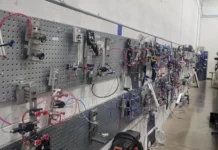by John Pizzo, Sun Plastech, Inc.
The plastic waste created every day by poor resin color changes and product contamination is a significant drain on the efficiency and profitability of processors already under pressure from a highly competitive global marketplace. Plastics processors have reacted to this challenge by introducing new management and quality enhancement techniques, as well as a variety of new materials and equipment. Companies not evolving to meet these challenges are going out of business or being consumed by those that do progress. One significant processing-related change in the thermoplastics-processing industry is the growing acceptance of commercial purging compounds (CPC).
Why purging compound?
The need for effective purging of processing equipment continues to increase in importance. Some problems confronting processors are: increased frequency of material changes due to an increased number of grades / colors of resins; increased high-quality competition; increased cost and difficulty of waste disposal; and an increase in customer demand for a wide variety of JIT-customized products. Therefore, there are many opportunities at the processing site to reduce costs by increasing the focus on purging operations. Purging of processing equipment with a minimum quantity of material, in a minimal amount of time and at the lowest total cost has become a significant element that influences many processors’ competitiveness. For example, reducing the time required to purge a 300- ton injection molding press (assuming $50/hour cost) by just 10 minutes per day would result in a savings of over $3,000 per year!
In the past, one of the most popular methods of purging was using the next resin to be processed or using scrap (regrind). However, this method is like “washing clothes with water alone” instead of using laundry detergent to remove non-water-soluble stains. With this method, the loss of time and material can be considerable. Additionally, contaminants tend to develop and accumulate during long production runs. It is reasonable to accept that scrap or the next resin, just like “washing with water alone”, cannot purge contamination such as carbonized resin. If natural resins could remove degraded resins, contamination would be removed continuously from the machine rather than increasing during the course of a production run. As a result of this prolonged residence of resins in a machine, deterioration and, subsequently, defects are likely. Just as detergents are indispensable for washing clothes, a high-performance purging compound should be indispensable in thermoplastic processing plants.
Criteria for evaluating purging compounds
Trial and error often is required when choosing a purging compound, although it sometimes comes down to preference. In some instances, a particular production process responds best to a specific type or “category” of purging compound. There are a variety of commercial purging compound (CPC) categories common today, such as mechanical-type purging compounds, chemical-action products and mechanical-chemical hybrids, to name a few. These products, as their category names suggest, are classified based upon their method of action and/or their ingredients. However, regardless of the type of purging compound, there are important overall factors that should be considered when evaluating a CPC:
Total purging cost:
- the initial cost of the purging compound
- the amount of time required for the purge (translated into machine downtime cost)
- the amount of defective product (rejects) produced while purging
Performance of purging compound:
- Cleaning power – The amount of purging compound required for elimination of all unwanted resin or contamination from the system
- Residue – The amount of the next resin required to eliminate the purging compound entirely from the system being purged
- Ease of use – Procedures required for effective product use should be minimal and simple to perform.
Environmental friendliness: The purging compound should not have adverse effects on the operating personnel, plant equipment, the environment or the physical properties of the finished product.
Verifying cost savings
It’s clear that an effective purging compound should provide a processor with measurable cost savings, and there are a number of ways of determining what these savings are or could be. The easiest way is if the CPC supplier has a cost savings analysis (CSA) tool. A good CSA tool will take into consideration most of the criteria mentioned earlier, particularly machine downtime and material costs. It also should compare the CPC being evaluated versus the processor’s current purging method. Figure 1 on page 35 illustrates a CSA performed by Sun Plastech Inc. (ASACLEAN). It compares one of its grades versus purging with the next resin, and it shows a 56 percent savings per purge. It further extends the analysis to show a yearly savings of more than a $46,000 on this application alone.
Processors also can take it upon themselves to determine the value of their purging method. For example, in Figure 2 above, a processor studied the effect of a CPC on the reject rate on several of its machines. The previous method involved tearing down the machines and installing clean screws. Reject rates climbed invariably over time for both machines as contamination accumulated. As expected, the reject rates decreased when introducing the CPC (in this case, ASACLEAN) and then climbed again during the control period of not using the CPC. As soon as the CPC was reintroduced into the study, the reject rates decreased and continued to decrease to never-before-seen lows.
Conclusion
Most thermoplastic processing facilities would benefit from using a commercial purging compound instead of scrap or the next resin, despite their deceptive low cost. To properly evaluate the actual cost-effectiveness of a purging compound, all cost factors must be considered including material, machine, labor, lost production, scrap handling/reprocessing, waste disposal and customer satisfaction. These cost savings may range from as little as 1 percent to as much as 5 percent. Without effective purging techniques, it is unlikely that any plastics processor will remain economically viable in the increasingly-competitive global marketplace.
John Pizzo is the technical service and development engineer for Sun Plastec, Inc., the maker and distributor of ASACLEAN purging compound. For more information, call 800.787.4348 or visit www.asaclean.com.




